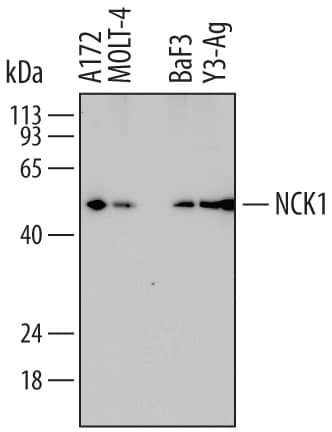Human NCK1 Antibody
R&D Systems, part of Bio-Techne | Catalog # MAB7008

Key Product Details
Species Reactivity
Validated:
Cited:
Applications
Validated:
Cited:
Label
Antibody Source
Product Specifications
Immunogen
Met1-Ser377
Accession # P16333
Specificity
Clonality
Host
Isotype
Scientific Data Images for Human NCK1 Antibody
Detection of Human, Mouse, and Rat NCK1 by Western Blot.
Western blot shows lysates of A172 human glioblastoma cell line, MOLT-4 human acute lymphoblastic leukemia cell line, BaF3 mouse pro-B cell line, and Y3-Ag rat myeloid cell line. PVDF membrane was probed with 1 µg/mL of Mouse Anti-Human NCK1 Monoclonal Antibody (Catalog # MAB7008) followed by HRP-conjugated Anti-Mouse IgG Secondary Antibody (Catalog # HAF007). A specific band was detected for NCK1 at approximately 47 kDa (as indicated). This experiment was conducted under reducing conditions and using Immunoblot Buffer Group 1.NCK1 in MCF‑7 Human Cell Line.
NCK1 was detected in immersion fixed MCF-7 human breast cancer cell line using Mouse Anti-Human NCK1 Monoclonal Antibody (Catalog # MAB7008) at 25 µg/mL for 3 hours at room temperature. Cells were stained using the NorthernLights™ 557-conjugated Anti-Mouse IgG Secondary Antibody (red; Catalog # NL007) and counterstained with DAPI (blue). Specific staining was localized to cytoplasm. View our protocol for Fluorescent ICC Staining of Cells on Coverslips.Applications for Human NCK1 Antibody
Immunocytochemistry
Sample: Immersion fixed MCF‑7 human breast cancer cell line
Western Blot
Sample: A172 human glioblastoma cell line, MOLT‑4 human acute lymphoblastic leukemia cell line, BaF3 mouse pro-B cell line, and Y3‑Ag rat myeloid cell line
Formulation, Preparation, and Storage
Purification
Reconstitution
Formulation
Shipping
Stability & Storage
- 12 months from date of receipt, -20 to -70 °C as supplied.
- 1 month, 2 to 8 °C under sterile conditions after reconstitution.
- 6 months, -20 to -70 °C under sterile conditions after reconstitution.
Background: NCK1
NCK1 (Non-catalytic region of tyrosine kinase 1; also Sh2/SH3 adaptor protein NCK-alpha) is a 46-48 kDa member of the Nck family of adaptor proteins. NCK1 is ubiquitously expressed and may be found in both cytoplasm and nucleus. In the cytoplasm, it connects tyrosine kinases to actin reorganization which, in T cells, involves SLP-76 and VAV1. Upon DNA damage, NCK1 binds SOCS7 and is translocated into the nucleus where it participates in p53 phosphorylation and cell cycle arrest. Human NCK1 is 377 amino acids (aa) in length. It contains three N-terminal SH3 domains (aa 2-252) that mediate binding to Pro-rich regions of cytoplasmic proteins, and a C-terminal SH2 domain (aa 282-376) that binds to phosphorylated proteins or receptors. There are at least three utilized Ser, and one utilized Tyr phosphorylation sites. There are also three potential splice variants. One shows a 12 aa substitution for aa 1-76, a second possesses an 11 aa substitution for aa 77‑377, and a third contains a 37 aa substitution for aa 134-377. Full-length NCK1 shares 99% aa identity with mouse NCK1.
MAB7008 detects mouse and rat NCK1 in Western Blots. Cross-reactivity with mouse and rat samples in immunocytochemistry has not been tested.
Long Name
Alternate Names
Gene Symbol
UniProt
Additional NCK1 Products
Product Documents for Human NCK1 Antibody
Product Specific Notices for Human NCK1 Antibody
For research use only

